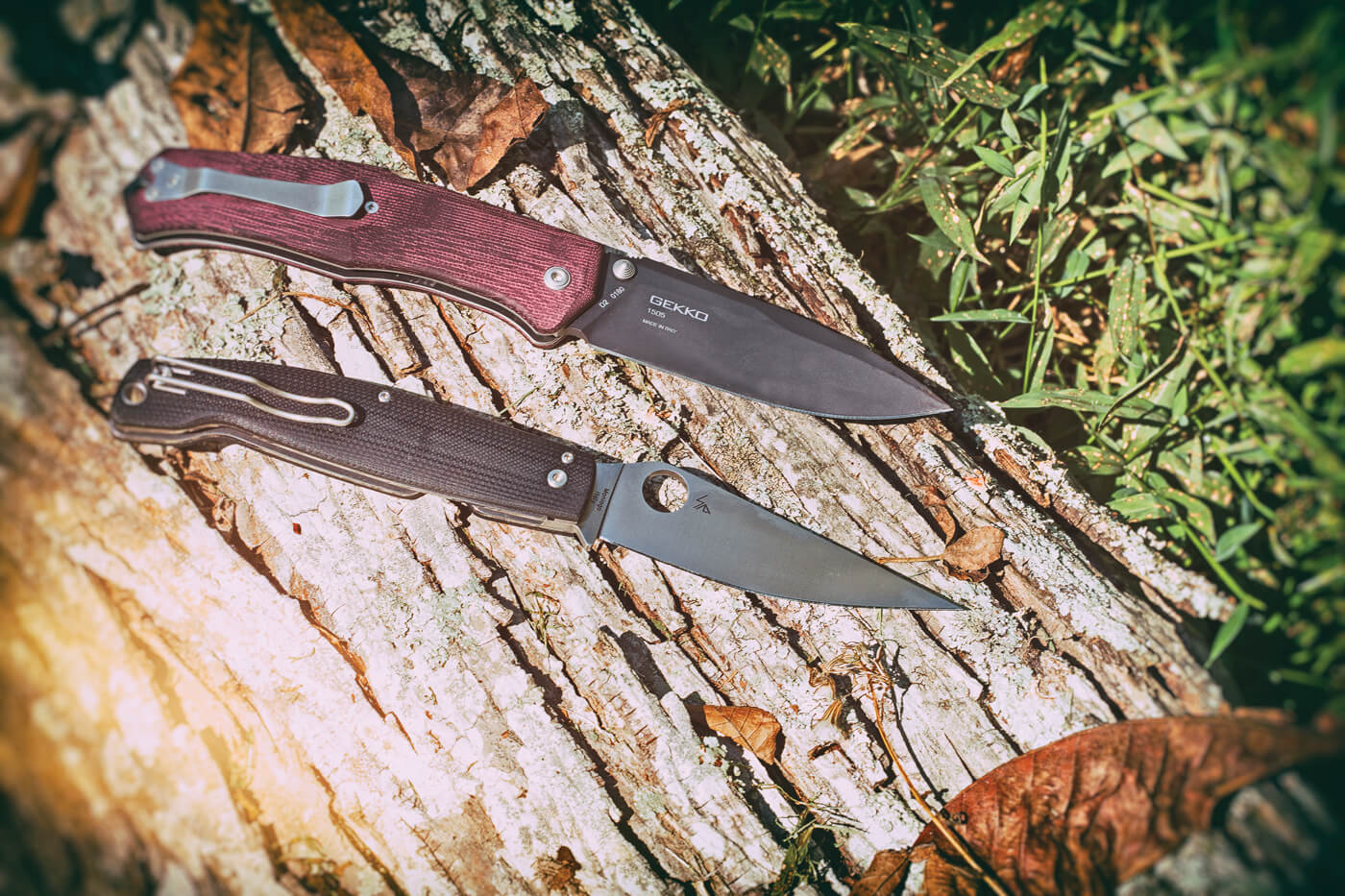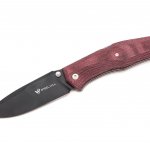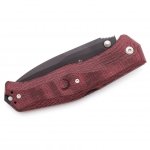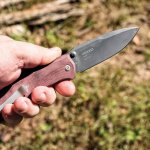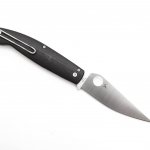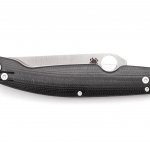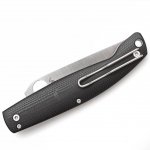You all know the expression, “You can never have too much money.”
In the preparedness world, the same is pretty much true with knives—particularly folding knives. One of the critical abilities a person must have in a survival scenario is the ability to cut things. And while flint-knapping is a way to get you what you need, it’s much easier to have knives already on hand.
Although not as robust as most of their fixed-blade brethren, folding knives have a unique characteristic all their own: portability. The design nature of folding knives inherently makes them relatively compact tools that are easily carried and stowed just about any place you want.
While out in the field, it’s always a sound practice to carry a folder as a backup to a fixed-blade knife. If an individual works in an office environment where a 6-inch fixed blade wouldn’t quite match the slacks and tie, it’s still an easy affair to have a substantial folder secreted away in a pocket.
For this review, we received a couple of folding knives that are prime examples of what one might carry, whether out on the trail or simply behind a desk or around the house. The two folders we had a chance to try
out are the Steel Will Gekko 1505 and the Spyderco Pattada.
THE GEKKO 1505
Because of the materials used and the blade profile, the Gekko 1505 is going to be recognized by most as an
“outdoors” knife, making it a perfect travel companion for your favorite fixed blade. The blade has a drop-point profile that’s a favorite design for dressing and cleaning game.
The blade is also made of D2 steel (HRC of 59-60), which has long been popular for working with game because of its toughness, semi-corrosion resistance and its ability to take a keen edge—provided it’s of quality composition and properly heat treated. Another check in its favor is that D2 steel does not have the hefty price that some of the newer “super steels” carry.
Because of the materials used and the blade profile, the Gekko 1505 is going to be recognized by most as an “outdoors” knife, making it a perfect travel companion for your favorite fixed blade.
The grip slabs on the Gekko 1505 are maroon Micarta. This is a sound choice for an outdoors knife, because Micarta provides a very secure grip when the handle is wet from rain or blood while cleaning game. In my opinion, the maroon Micarta is a refreshing change (not widely used on production knives), and it’s also an excellent complement for the black PVD-coated blade.
The overall length of the Gekko 1505 is 8.98 inches—no slouch in the size department. It boasts a 3.94-inch blade length with an accompanying thickness of .14 inch. The locking mechanism is a lockback affair, and the pocket clip can be moved to either side of the handle for both left- and right-handed users with a tip-up carry position.

• Overall length: 8.98 inches
• Blade length: 3.94 inches
• Blade thickness: .14 inch
• Blade steel: D2
• Blade finish: Black PVD
• Hardness: HRC 59-60
• Handle: Micarta
• Lock type: Lockback
• MSRP: $239.99
THE PATTADA
In the heart of one of the most beautiful regions in the world is the island of Sardinia, the largest island in the Mediterranean Sea. Near the center of the island is a village called Pattada, which has become well known for its skilled blacksmiths and knife makers. The village of Pattada has, over the years, generally been given credit for the resolza (folding knife), although the knife was a common style throughout the entire island.
In its customary manner of celebrating the ethnic blades from around the world, Spyderco has released its tribute to the resolza with its own knife, the Pattada. In addition to celebrating the Pattada’s heritage, Spyderco has also offered a couple of refinements to help bring the design into the 21st century.
True to the knives of the Pattada area, Spyderco’s version has a slender, leafshaped N690Co steel blade with a full, flat grind. The blades of that region were shaped to mimic the leaf of a myrtle tree. The Spyderco Pattada has a shorter blade length than those of common resolzas, but that’s to ensure portability and ease of manipulating the knife one-handed. The blade length of the Spyerco Pattada is 3.92 inches with a thickness of just .138 inch.
Spyderco has released its tribute to the resolza with its own knife, the Pattada. In addition to celebrating the Pattada’s heritage, Spyderco has also offered a couple of refinements to help bring the design into the 21st century.
The grips of traditional resolzas were made of mouflon horn, but because of their lower population levels, ram’s horn is the more common choice in modern times. Spyderco’s rendition keys in on modern materials by using G-10 for the grip slabs, which ride atop stainless steel liners.
Another enhancement for the Pattada is a strong liner lock—a lock style commonly found on modern knives. Traditional resolzas are friction folders with no mechanical devices or locking mechanisms. While I can appreciate traditionally built knives, if it’s going to be a user, I prefer a good lock.
And finally, there is the addition of the spring-wire clip to facilitate accessibility in the pocket; it is also ambidextrous and designed for tip-up carry. While the Pattada might look more like a gentleman’s knife at first glance, it has a strong history of being a formidably versatile knife. For centuries, it has been used by farmers, sheepherders and outdoorsmen, and it was a common practice to carry it into war when it came time to serve.

• Overall length: 8.69 inches
• Blade length: 3.92 inches
• Blade thickness: .14 inch
• Blade steel: N690Co
• Blade finish: Satin
• Handle: G-10
• Lock type: Liner lock
• MSRP: $289.95
SERVICE TIME
To be a good folder, a knife doesn’t necessarily have to be a “woods” knife. There are plenty of urban scenarios in which a folder is just as useful. Luckily, both knives were more-than-capable products that were able to do just about any job thrown at them (within reason), although each one excelled in particular areas.
Honestly, whether in an outdoors setting or in the heart of a city, folding knives are generally used for lots of menial chores such as cutting open packages, cutting cord and other mundane tasks—unless they are specialty knives for things such as woodwork, maritime jobs and the like. For the everyday stuff, both the Pattada and the Gekko 1505 can more than handle whatever the average Joe might need done.

The Gekko 1505 is a rather stout knife with a wide blade, and it performed well with certain chores such as shaving off wood curls for tinder to make a fire. It wasn’t quite as adept as a bushcraft knife specifically designed for that type of work, but that’s the nature of compromise when it comes to a folder.
The edge on the .14-inch-thick blade of the Gekko 1505 was shaving-sharp, and with the blade profile and the handling of the 1505, there’s no question that it would make an excellent hunting knife for cleaning game. Hunting season wasn’t in play yet, so there wasn’t a true way to tell, but there’s a certain confidence of knowing by how a knife handles other tasks.
… folding knives have a unique characteristic all their own: portability. The design nature of folding knives inherently makes them relatively compact tools that are easily carried and stowed just about any place you want.
The Pattada was just as effective in other particular areas. Because of its narrow blade and the slightly rounded belly, the Pattada makes an excellent food-prep knife for camp or the trail.
With its scalpel-keen edge, the Pattada is an efficient slicer, and with its upswept belly that comes to a fierce point, it’s also an excellent tool for penetration. These characteristics make for an effective defensive tool, particularly because of the strong liner lock that’s in place.
The myrtle-leaf profile of the Pattada’s blade, along with its .14-inch thickness, makes the Pattada a viable fish and small-game knife or even a boning knife if needed. The handling is quick and nimble, and the G-10 grips are extremely comfortable to use during extended periods.
FIELD OBSERVATIONS
For 90 percent of the jobs for which folding knives are used, both the Pattada and the Gekko 1505 are very effective and will perform equally well. For the other 10 percent, each knife has its own particular strength in situations in which it excels.
Even so, an individual could manage their way out of a desperate situation with either knife. The key is having a quality folding knife overall, one that is built with a solid design and incorporates superb materials. Both knives are more than covered in this regard.
Even though this started simply as an overview of two knives, it’s human nature to turn it into a competition, especially when the two knives are within about $25 of each other when it comes to street price. The question that begs to be answered, knowingly or not, is, Which one is the best?

My response will have to be a bit snarky as I go with … both. When it comes to overall performance, the Pattada and the Gekko 1505 match up pretty evenly; however, they are just different enough that I can see using each one at different times.
For days when I’m going to be no place but in the woods, whether to hunt or just slip away and enjoy the outdoors, I believe the Steel Will Gekko 1505 would find favor for pocket carry. It’s a robust knife that’s built Hell-for-stout and has the drop-point profile that is favored by hunters and general outdoorsmen, alike.
But for times when I’m at work, around town or generally in the company of others, the Pattada would be my first choice. Its slightly more sophisticated appearance blends in better with an urban setting, and the blade profile makes it an excellent defensive tool, in addition to being a simple EDC folder.

of its blade edge made it an excellent food-prep knife.
Both knives are excellent specimens, representing the leading edge of knife manufacturing, materials and aesthetics. Either one is worthy of your hard-earned money.
But why stop there? Pack one in a kit; use one for daily carry; throw another in a coat pocket or a pack. When it comes to being prepared, having a backup is a cardinal rule, and, as we discussed at the beginning, you can never have too much money … or too many knives.
Spyderco
(800) 828-1925
www.spyderco.com
Steel Will Knives
(877) 969-0909
www.steelwillknives.com
Editor’s note: A version of this article first appeared in the October 2016 print issue of
American Survival Guide.


